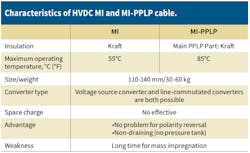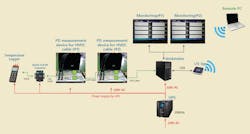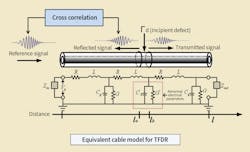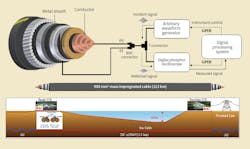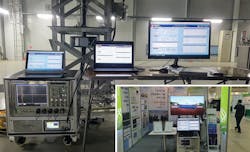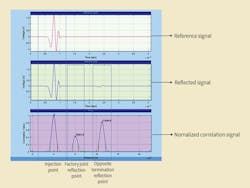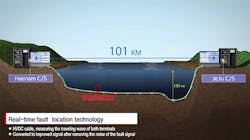High-voltage dc cable is a core technology for long-distance power transmission and has made it possible to interconnect power systems over long distances between countries and land masses separated by water. Unlike ac underground cables, dc cables are not affected by capacitive charging current, dielectric loss or sheath loss, thus enabling long-distance and high-capacity transmission of electric power. Moreover, the conductor resistance is low, leading to low transmission loss. With the ease of power flow and load control, utilization of the line can be maximized.
However, it is not easy to obtain an accurate fault location for a long-distance high-voltage dc (HVDC) submarine power cable. A prime example of this is when it took more than three months to locate a fault on the ±400-kV Basslink submarine power cables connecting the state of Victoria in Australia to the island of Tasmania. The fault occurred in December 2015 and was originally estimated to be fixed in February 2016. However, the fault location was not identified until the end of March 2016. The line was finally restored in June 2016 — six months after the fault occurred.
To address the fault location limitation of HVDC submarine power cables and secure the operational reliability of its long-distance submarine power cables, Korea Electric Power Corp. (KEPCO) has developed the new on-line and off-line fault location technologies. It has also developed a partial discharge diagnosis technology for real time monitoring of HVDC land cables. The measurement system incorporates both off-line and on-line fault location technologies and currently is in operation on the 300-MW Jeju-Haenam HVDC submarine power cable system — consisting of two 180-kV cables — connecting Jeju Island, off the coast of South Korea, with the mainland.
Online Diagnostic Tech
Partial discharges can indicate insulation quality has degraded, which can lead to costly repairs and, even worse, an electrical breakdown of HVDC cable. The presence and magnitude of partial discharge are important criteria to measure for the early detection of degrading insulation quality. Testing of partial discharge is complex, but accurate interpretation of partial discharge data can be extremely useful in predicting failures and estimating useful life of cables.
KEPCO’s partial discharge measurement system is a testing mechanism that is interoperable with a variety of equipment and comprises multiple channels, which enable frequency analysis, pulse analysis and time-difference analysis for each piece of equipment. Two channels are in place specifically to measure the cable temperature, which is closely related to the occurrence of partial discharge in HVDC cables. Using these two channels, the temperature data is synchronized.
KEPCO continuously measures 500 kV dc N. Dangjin-Goduk HVDC land cable using two 8-channel measuring devices. Various sensors are connected to the input ports on each channel of the system to measure the partial discharge characteristics in the HVDC cable. By measuring in this manner, the data can be comparatively analyzed with a focus on the magnitude of discharge occurrence using a pattern analysis system, developed based on empirical data of partial discharge of HVDC mass-impreg-nated polypropylene-laminated paper (MI-PPLP) cable.
Suitable for voltages of up to 500 kV dc and lengths of up to several hundred kilometers, mass impregnated (MI) cable insulation consists of high-density kraft paper tapes impregnated with a high-viscosity compound that does not require fluid-pressure feeding. More recently, MI-PPLP was developed to meet requirements for higher voltage and better capacity. While its main insulation is PPLP, one layer consists of kraft-polypropylene film-kraft, which improves the HVDC cable’s dielectric performance and increases the maximum allowable temperature.
In addition, by applying a six-pattern classification technique, it is possible to distinguish any disparity between the normal-state and abnormal-state partial discharge patterns. In the normal state, a before-and-after analysis of the discharge amount shows it is characteristic to have clusters concentrated in the center, whereas in the abnormal state a spread in the center is observed. In addition, the density of a high discharge amount increases with the class analysis of the frequency by the magnitude of discharge.
Off-line Fault Location
The off-line fault location technology in the partial discharge measurement system applies time-frequency domain reflectometry (TFDR), which diagnoses cables by analyzing the reflected signal from the point where the fault occurred in the time-frequency domain. It exhibits distinct features that complement the limitations of the conventional time-domain reflectometry (TDR) and frequency-domain reflectometry (FDR) while also accounting for the resolution of both the time and frequency domains. To improve the accuracy of this method, KEPCO designed the input signals so the phase of the cable frequency response would fall into the linear section.
KEPCO verified the performance of its partial discharge measurement system by conducting experiments on an existing long-distance power cable system: the ±250-kV, 113-km (70-mile) Jeju-Jindo HVDC submarine cable. It consists of 900-sq mm (subsea) MI and 1000-sq mm (land) MI cable types.
Prior to the newly developed TFDR algorithm, it was difficult to observe visually the variation in a factory joint measured through the reflection of the reference signal. However, when testing the TFDR algorithm, even a factory joint located 50 km (31 miles) away from the measurement site could be observed. High-resistance failures of a long-distance cable also could be detected.
Online Fault Location
On-line fault location technology is used for real-time detection of fault points. It measures a signal generated when a fault occurs through terminals of both sides and locates the fault point through a time difference between the first traveling wave peaks at the terminals of both sides. To minimize errors caused by external noise, KEPCO incorporated a noise-cancellation technique of wavelet multiscale correlation.
The real-time fault location technology is installed and currently in operation on the ±180-kV Jeju-Haenam HVDC submarine cable. The 101-km (63-mile) line runs from the Haenam converter station in South Jeolla Province, South Korea, to the Jeju converter station on the island, and all but 5 km (3 miles) of the cable is partially buried undersea. The fault location technology consists of two modes: Mode 1 is a trigger monitoring system and Mode 2 is a real-time monitoring system installed in each local converter station, where the real-time load current and fault current are monitored simultaneously at Modes 1 and 2 to detect and locate the fault point.
The main screen of the real-time fault location software provides the main control menu and real-time load current. It also displays information related to fault occurrence and equipment operation statuses.
Two-Pronged Approach
KEPCO has improved the operational reliability of its HVDC submarine lines by developing a monitoring system that uses a two-pronged approach with both on-line and off-line fault location technologies for fast recovery. In addition KEPCO has developed the partial discharge diagnosis technology for real time monitoring of HVDC land cables.
About the Author
Chae-Kyun Jung
Chae-Kyun Jung ([email protected]) is a principal researcher in the power transmission laboratory at KEPCO Research Institute. He is responsible for several areas of research, including the insulation diagnostic technology of high-voltage dc cable systems, fault location, transient analysis of the power system and power cable performance testing. He received his Ph.D. degree in electrical engineering from Wonkwang University, South Korea, in 2006. From 2006 to 2007, he worked at the University of Siegen, Germany, as a postdoctoral researcher. He has been with KEPCO Research Institute since 2007.

